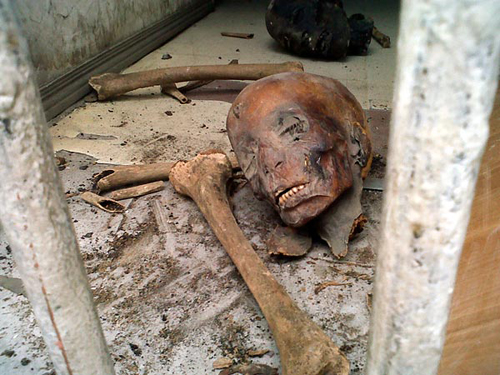
The fabric of our lives, naturally preserved artifacts, can be worth some serious dough — but people rarely get away with heisting these valuable artifacts due to the major security in museums all over the world. Riots and looting, however, sometimes trump these security measures and many artifacts are destroyed in the process. But shameless looters are not the only reason you won’t see your favorite Chinese tombs in a museum near you — natural disasters, careless construction workers and angry evangelists also make appearances on this list of 5 incredibly valuable artifacts that were destroyed.
The Museum of Egyptian Antiques

Loot like an Egyptian? With political unrest reaching a fever pitch throughout Egypt earlier this year, a group of protestors in Cairo decided to focus their anger on the past instead of the present when they broke into The Museum of Egyptian Antiques . At first taking to the newly renovated gift shop and café for over-priced jewelry and snacks, the looters then moved into the museum itself and ran amuck on some of Egypt’s most valuable pieces currently in preservation. By breaking through the glass-paned ceiling and sliding down ropes, nearly 50 Tom Cruise-wannabes trashed various artifacts in the Late Period gallery, stole ancient treasures and destroyed a well-known statue of King Tut on a panther. Which is upsetting, because that sounds both incredibly noble and visually hilarious.
National Museum of Iraq

Looters were also the cause of more cultural devastation as groups of aggressors managed to steal more than 15,000 registered objects from the National Museum of Iraq during the month that preceded the 2003 Iraq War. While precautionary measures were attempted in order to secure the museum in the months leading up to the war, looters still managed to walk away with some of the museum’s most historically important pieces. Most of the stolen antiques were assumed destroyed, but nearly 5,000 items were later recovered –Three of which were determined to be the most valuable pieces missing: the Sacred Vase of Warka, the Mask of Warka and the Bassetki statue. Various items were reportedly scattered throughout Jordan, France and Switzerland; the headless stone statue of the Sumerian king Entemena of Lagash, however, was found in the good ol’ U.S. of A (along with almost 1,000 additional artifacts), thanks to aid from a New York art dealer who had encountered the piece. For his troubles, the dealer asked the Iraqi government for his full commission rate and a live scorpion. Neither was granted.
Chinese Construction Mishaps

So who’s the jerk in China who ripped into 100 ancient tombs like a 7 year-old on Christmas morning? No one seems to be certain, but because of the “improper excavation of the local cultural relic department” in Xi’an’s Chang’an District in 2005, they’re all ruined. WAY TO GO, GUYS. The tore-up tombs were evidence of several dynasties (Han: 206BC-AD 220, Sui: 581-618, Tang: 618-907) found scattered in the Zhixin Cherry Blossom Garden in Guodo Town. Apparently this is becoming an unfortunate trend in China though, as construction workers in Nanjing accidentally destroyed 10 more ancient tombs in 2007. What were they working on, you ask? A magnificent cultural institution? A stately cathedral? Nope. An Ikea. They ruined artifacts dating back 1,800 years to construct a Swedish furniture store. Let’s hope they’re enjoying their Dagstorps and Karlstads, because who wouldn’t want a loveseat that lasts a year instead of a piece of history that has lasted lifetimes?
Women’s Club of Huntington Beach fire

It was neither stupidity nor greed, but instead fire that resulted in the loss of a century’s worth of artifacts at the Women’s Club of Huntington Beach. In 2005, a tremendous fire, which required the attention of more than 50 firefighters and several gallons of always-comforting ice cream, burned the Women’s Club to the ground and engulfed everything inside it. The Women’s Club moved into the building in 1916, and some of the items lost included an antique grand piano, dishes that were used to serve regular meals to members during its inception and decades-old paper records. The club was renowned as an important part of the local community as well as an important part of local history. The members of the club helped establish the city’s first library and held countless educational programs in the early 1900s that were widely unavailable for women at the time. Women’s Clubs everywhere intended on holding candlelight vigils in memoriam of the tragedy, until they realized it was likely a fire hazard and drank wine instead.
Nigerian Pentecostal Church burnings

Several years ago, many members of the Pentecostal Church in Nigeria started burning centuries-old, extremely valuable African artifacts to blatantly erase history. Because if someone burns a shrine in a forest, it never really existed and no one ever prayed to it and congratulations, you are probably going to hell for that … right? Led by pastors of the Pentecostal Church, members have been urged to both reject and destruct any “paraphernalia of ancestral worship.” That means that anything they own, as well as anything their neighbor owns, should most definitely be bonfired. One community in the rainforest belt has repeatedly had to defend its carved god figures and ceremonial costumes from looters and recently instated a gong to sound an alert for intruders. One participator happily confessed his involvement in the bonfires saying that “I had experienced a series of misfortunes and my pastor told me it was because I had not completely broken the covenant with my ancestral idols. Now that I have done that, I hope I will be truly liberated.” Let us know how that works out for you, buddy.